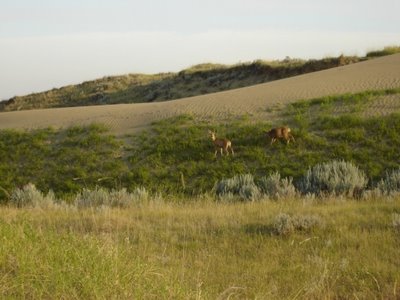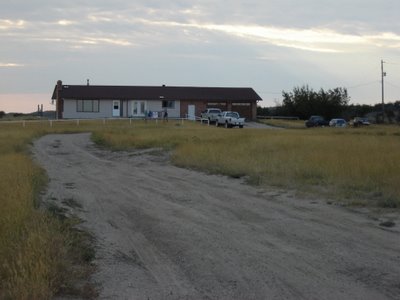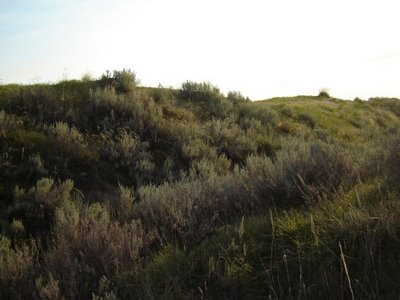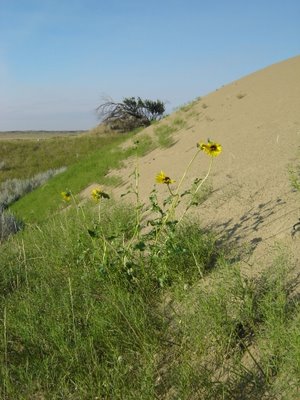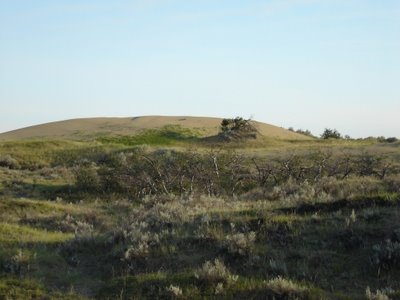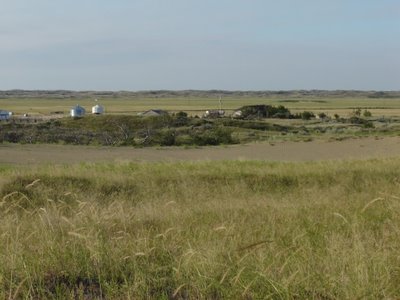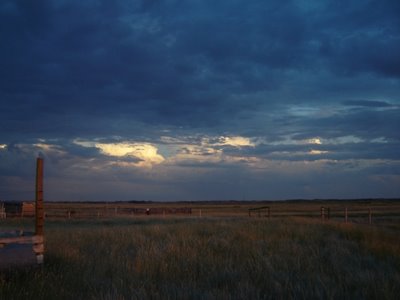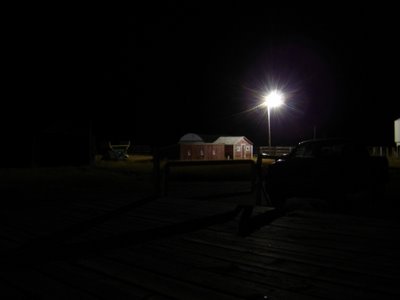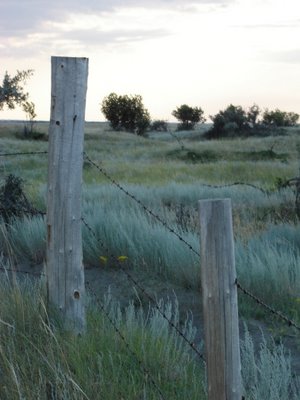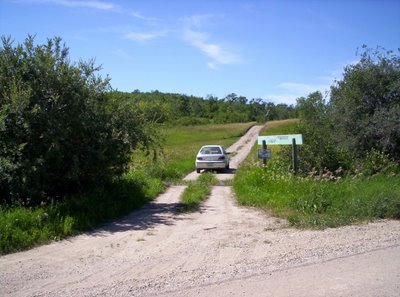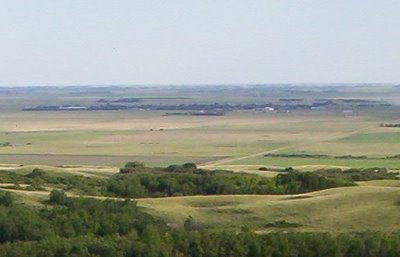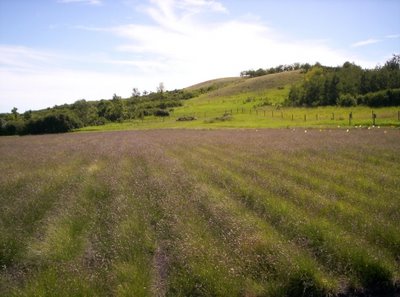"How are the hazelnuts?" I asked.
"Terrible," was the reply. Mom and Dad figured that, with so little berry and seed production generally this year, anything that did grow had been snapped up.
We were chatting over lunch. I had spent the morning helping Mom in her seed gardens, in exchange for her listening ear, while James helped Dad lay some laminate flooring, in exchange for some spending money. Through the early afternoon, I played Dad's guitar with half my attention, and chewed over my favourite dilemmas some more with Mom. When the temperature outside was peaking, I decided I really needed to spend some time just walking the land. In hindsight, I think Mom probably needed some time to shake herself free of my burdensome talk.
As I climbed the trail behind the house, I thought of the camera I didn't bring. Just as well, I told myself. This time is for me, not for the blog.
I went first to the summit of Anemometer Hill, perhaps the highest point of our little highland, which is itself the highest land within the surrounding several miles of hills. I stood a few minutes just soaking up the vista to the west. And I heard myself discussing that view with blog readers, debating the definition of a hill.
The landscape is very striking these days, with the grass on the ridges dry and bleached pale, while the aspen and shrub areas are still a rich dark green. There was no water visible in all those miles of view, but I knew where I would find it.
I moved on, away from the usual routes along mowed trails, and into the bush. The cattle-and-deer trails have shifted a little since the days when I did a lot of roaming, and I spent some time weaving from one hint of a trail to another before I found the main thread of the path I remembered, and emerged onto the tiny grass area that faces northwest just off the crest of the same height of land.
I was surprised to see a large patch of blue on the neighbour's pasture to the north. That slough must be holding up well in spite of the recent drought. Maybe the rain on Tuesday brought the level up some.
Down the north slope I went, watching my footing and still slipping a little, pausing to gaze up and around at the birches and the forest canopy stretching away, and to wonder if I could capture the sense of this place in a picture. Ah, the blog had followed me here, too.
There were hazelnuts. Some were ripe already - I've never seen them that early. Twila and I used to pick them around the first weekend in September. As I moved down the slope, my path unravelled into fading threads in the hazelnut understory. A bit of colour off to the right caught my eye - high-bush cranberries! Turning red, here in the second week of August.
I cast about for the best offer of a trail, and then, noticing a brightness that might be an opening, I went sideways. What I found was more than an opening; it was the mowed trail along the toe of the north slope, and I'd have been on it in only a few feet more, if I had just pushed straight ahead.
I let it lead me west. At the edge of the hay field I paused to enjoy the return of the breeze and the last of the shade. Not a spectacular view at that spot. Dad had said something about the view I could get from the house site I'd mentioned to him - the latest dream site in a long series. I asked myself: do I need a good view? That's what walks are for. Too good a view, and I might just sit at home.
I took a few swallows from my too-small water bottle, and set out across the sun-burnt hayfield, moving gently in the heat. When the truck trail turned south, I continued west on a cattle trail toward the dam.
The ravine here used to be densely forested, like most ravines in these hills, but now there is not a large tree anywhere near the dam. It was the death of the trees, that dam, because it brought the beaver.
I remember how I used to analyze the landcover as I roamed, noting all the ways that previous tenants of this land had changed things. Now when I wander, I notice new changes, wrought by my own family, and sometimes even by me.
I wonder if Mom and Dad would have put that dam in, had they realized what the beaver would do. The first few years of impact were the most obvious, as that swath of forest fell. I might have thought that it would end there, after the beaver ran out of trees within a reasonable radius of the water. Yet now - how many years later? ten? fifteen? - the beaver's work goes on, mostly out of sight, unless you take the time and effort to walk the ravine downstream.
I crossed the dam, pausing to admire butterflies puddling on the damp mud, duckweed stippling the water surface, and a robust sedge that's new since my last visit, growing on the seepage areas of the downstream side. At the dry spillway I hesitated. I wanted to walk the bottom of the ravine, but I knew the beaver had wreaked havoc with the cattle trail down there, drowning it under a series of small pools created when they built one little dam after another below our big dam. From what I could see from my high vantage point, the problem hadn't resolved itself yet.
A new option beckoned, though: beyond the spillway, the cattle trail continued up and across the north bank of the ravine. I followed.
It was a good trail, much better than I remembered from the last time I wandered here, and taking an unusual course across the midslope. Cattle tend to drift to the bottom of slopes like this. Midslope trails do exist, winding (like this one) along where the bush ends and the grass of the upper slope begins, but on a steep sidehill, they are rarely so well travelled. I suspected that this was an effect of the beaver's work below.
Finally the trail plunged down into the thick forest, down, down, driving my toes painfully into the fronts of my boots. When the ground flattened out, the understory opened suddenly into a magical grassy place overarched with great old trees. The confluence, I realized - the place where the dammed ravine joins the Deep Ravine. This deep ravine was a dark, mysterious barrier to much of my childhood wanderings, and it poses such a restriction to westward movement that it forms a sort of boundary of our farm, though the cattle do use the thin wedge of upland pasture that lies beyond. For some years there was no fence on the west, and the Deep Ravine functioned as a real boundary, as our cattle kept mostly to the east of it, and the neighbours' stayed mostly west. (By the way, I'm calling it "our farm" for convenience - our farm, our dam, our cattle - but it's really my parents' farm. I just use it freely.)
Now I took a cattle trail south along the bottom. I had gone only a few steps though, when the scene changed dramatically. Great trunks of felled trees lay at angles across a bare mud hollow, bright with sunlight falling through the broken canopy. It was a beaver pond, now dry. I crossed its margin easily enough, but southward beyond its low dam I found a confusing jumble of very uneven ground, branches and logs, tangled vegetation, and haphazard trampling that never resolved itself into a reliable trail. The banks of the old winding streambed were carved up by frequent beaver "runs" (narrow deep ditches) and tunnels which had collapsed in places. As I ducked under a felled tree that hadn't fallen all the way, I realized with a shock that this was no longer a place where you would want to ride a horse. Was my memory reliable - did we ride here sometimes? I felt a guilty twinge at the thought that others may have ridden here sometimes, unconcerned about property lines, comfortable in traditions of use much older than my family's ownership of this place. If they did - and they certainly could have come here often without our notice - what did they think of the beaver works that we brought with our dam?
As I struggled on, past more dry beaver ponds and over more low dams, I noticed hoofprints in the mud and trampling in the grass, and still no trail. Suddenly I understood its demise. The problem was the pace of change. Trails shift, always, as trees fall, as soil slips, as shrubs grow up; when a new obstacle arises, the cattle and deer just push around it, and one animal follows another until a new path is formed. But here, the new obstacles were thrown up thick and fast, faster than the trail could weave itself around them.
Ah, I thought: the pace of change. This beaver problem was, at its root, no different than many, if not most, environmental problems. Nature responds to change; life goes on, and springs up new and different and wonderful all the same; but when the change is rapid, the response from nature can seem chaotic, inhospitable, or even violent.
Humans are certainly not the only living creatures that create rapid changes in their own environments. Obviously, beavers do. I found myself thinking about disease organisms, too, and how some of them bring about their own swift demise by killing their hosts. There is no need - and probably no advantage - to think of humans as uniquely self-destructive. Quite the opposite, I mused: it might be worth noticing how the consequences fall on any living thing that tips the gentle flow of its surroundings into a freefall. Being a part of the web of life is no guarantee of a safety net.
All the same, as I slowly picked my way southward, I marvelled unhappily at the long reach of the effects of that dam. Who would have guessed it? I might have imagined subtle changes in the moisture regime, and maybe some differences in the way tree seedlings got established, very slowly changing the downstream forest. But I never dreamed of changes so swift, so large, and so far.
I tired of my sad journey. I wanted to find the place where high-bush cranberries grew, to see if they were as abundant and advanced here as where I'd seen them earlier. But even that desire wasn't enough to keep me pushing south; not when I noticed a trail leading up the east bank. I gazed up it, trying to decide if it was trustworthy. Could it be just a beaver trail? Inviting, those trails, but fickle, petering out at the limit of the beavers' logging operations, with half the slope still to be climbed and nothing but dense hazelnut on every side.
I risked it. Soon I was standing, panting, heart pounding, leaned against a smallish black poplar, looking at the expanse of hazelnut understory above. No more trail.
Last time I made this mistake, I had a group of Mom's relatives with me, and we pressed on, crashing through that understory. It might have been the same beaver trail. It wasn't fun, at least not for me. I think some of the folks I was guiding astray actually enjoyed it, being so thoroughly out in the bush, and showing each other how rugged they were.
This time I turned back down. Partway, I was drawn to a great old tree. I leaned against it, and suddenly, awareness of its history washed over me. Here it had stood, through storms and snows, through the stillness of frozen winters and the pulsing riots of - how many springs? I moved in close against it, grateful for its strength. For a moment I could relax from my struggle with gravity on that steep slope. I wondered what it meant to the tree, if anything, to feel my weight against its trunk. I wrapped my arms around it, my fingers finding fitting places in the deep grooves of its rough bark. Never had I felt like this - well, never towards a tree! I laid my cheek against it, and stretched my neck to feel more of that bark touching my skin.
After a while I shifted my weight back onto my own feet, and looked up the trunk, trying to decide which kind of poplar it was. There were lichens at eye level, and just above I noticed the tiny delicate spore capsules of a moss. How very tiny they looked, against the bark of that great tree!
At last I moved on down the beaver trail, back to the bottom, back to the jumble of logs and branches, bush and rank grass, beaver runs and bits of old trail. I rationed my water and let my mind wander over a life that seems, these days, just as jumbled and tangled as that ravine bottom.
Suddenly one of those bits of old trail seemed to grow firm and smooth and familiar beneath my feet. That is what I noticed first: the smoothing of my footing. So striking was the change, that I dropped whatever thought I had been busy with, and looked around for the reason. I saw it at once: I was south of the beavers' work.
A few steps further, and a hawk streaked by above, moving with easy skill among the closely-spaced trunks of the poplars. A Cooper's hawk, perhaps. And only a moment later, a flurry of motion and sound on the path ahead resolved itself into the oddish outline of a ruffed grouse living up to its name. It occurred to me that this sudden abundance of birds was no accident. I could feel the difference in the forest here; the canopy was closed above, and the understory around me was slightly more open and variable. It was a friendly place.
A good path up out of the ravine soon presented itself, but I passed it by. The walk along the bottom was a joy again, a joy that reached all the way back to my teenage ramblings, untouched by disappointment.
I found the high-bush cranberries, laden with berries still mostly white. I came to a richly grassy place, and just below it, water trickled out of the gravel and flowed a little way along the streambed before sinking out of sight again.
Now I was ready. A little below the spring, a very good path led up the east bank, and I climbed, satisfied. My gaze lifted to the ridge high above, and I realized that this was Mom's ridge, the place where she says she'd like her ashes scattered.
I pictured that final moment of goodbye, and saw with wonder how happy and peaceful it could be. Mom's ashes would come home to a place that she loved without demanding anything of it, without aspiring that it become anything other than just what it was. There would be no distracting symbols of things that she accomplished, no sad unspoken thoughts of things she could not finish. Just her love, her freedom, and the beauty of this place.
I wondered if God approved of these thoughts. Before I even framed that question in my mind, I felt a rush of loving presence, seeming to say that approval really didn't enter into the matter. God was there embracing me - no, not even that far away. Looking out through my eyes and taking in my view with wondering love.
Yet close behind that feeling was a thought of suffering women, unspeakably suffering, trapped in a world of war and violence, of torture and rape and hunger and fear. I hardly noticed the rest of the climb. At the ridge-top, in the delicious breeze, I turned back to marvel at the great green trough of forest canopy below, but soon I turned away down a gentle grassy slope to the east, my mind full of the vague and awful plight of nameless women. I stopped and prayed for someone, that the living spirit might strengthen her to lift her broken body from its torment - to lift it, or to let it go, or to let it be. The prayer felt right and powerful at that moment, and yet now I cannot seem to put even the gist of it into words, and even the idea of it feels somehow false and contrived.
But after that point, my gaze and my thoughts were free again, and I enjoyed the simple satisfaction of reading the landscape in a not-so-familiar corner of the pasture and knowing just where to look for a trail through an aspen bluff. I crossed an area of tame hay, moving back towards the highland of our home quarter. Something on the steep slope above the hayfield caught my eye: a doe, moving swiftly downhill, but not in flight. The wind was towards her, and it amazed me that she came on down the slope, apparently unaware of my presence. She was moving almost directly towards me, but slightly to my left, and as she reached the lower ground, a low knoll hid her from my view. I resumed my walk, and when I came past the knoll, she was nowhere to be seen.
I climbed the ridge she had descended, but slowly, pausing often, drinking up the last of my water a few swallows at a time. It occurred to me that this was the ridge where Garth and I had sat, some years ago, at one of those times when things were particularly rough between us. Did we decide anything? The memory didn't offer any answer to that; just a vision of Garth's sadly earnest, hopeful face.
The saddle behind the crest of the ridge had nearly closed in with trees since then. I was moving faster, more purposefully, aware of the approaching supper hour. My thoughts became more purposeful, too, and I asked myself what I need.
My answer: I need a clear and simple path. No, I thought, not clear and simple.
Strait.
Notice the spelling: no "gh." Strait is a different word, and it has nothing to do with the shortest distance between two points.
It means "narrow."
As I imagined blogging about "strait" versus "straight," I found myself grinding my teeth. I couldn't be sure, but I suspected I'd been free of that tense habit for most of my walk.
I thought about one of my recent sermons, in which I explained my discovery that the "straight and narrow way" is not biblical. The way that Jesus spoke about was narrow, yes, but he never said it would or should be straight.
I need a narrow path, a deer-and-cattle path, just wide enough for my feet as I pass along my way. Anything more is a distraction, extra maintenance, a temptation to go sideways.
Now all I need to do is find that path.

